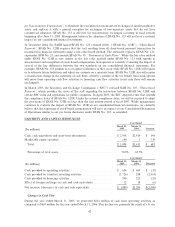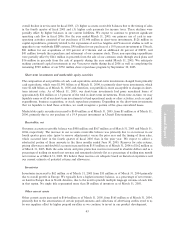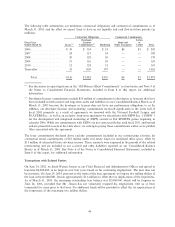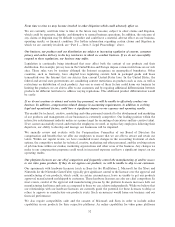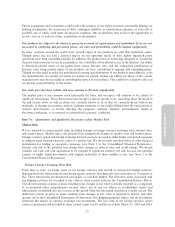Electronic Arts 2005 Annual Report Download - page 106
Download and view the complete annual report
Please find page 106 of the 2005 Electronic Arts annual report below. You can navigate through the pages in the report by either clicking on the pages listed below, or by using the keyword search tool below to find specific information within the annual report.platform. If the increased costs we have incurred and expect to continue to incur are not oÅset during the
transition, our operating results will suÅer and our Ñnancial position will be harmed. In addition, during this
transition, we expect our operating results to be more volatile and diÇcult to predict, which could cause our
stock price to Öuctuate signiÑcantly.
Our platform licensors set the royalty rates and other fees that we must pay to publish games for their
platforms, and therefore have signiÑcant inÖuence on our costs. If one or more of the platform licensors
adopt a diÅerent fee structure for future game consoles or we are unable to obtain such licenses, our
proÑtability will be materially impacted.
In the next eighteen months, we expect our platform licensors to introduce new video game platforms into the
market. For example, Microsoft and Sony have indicated that they plan to release next-generation successors
to the Xbox and PlayStation 2, respectively, over the course of the next eighteen months. In order to publish
products for a new game machine, we must take a license from the platform licensor which gives the platform
licensor the opportunity to set the fee structure that we must pay in order to publish games for that platform.
Similarly, certain platform licensors have retained the Öexibility to change their fee structures for online
gameplay and features for their consoles. The control that platform licensors have over the fee structures for
their future platforms and online access makes it diÇcult for us to predict our costs and proÑtability in the
medium to long term. It is also possible that platform licensors will not renew our licenses. Because publishing
products for video game consoles is the largest portion of our business, any increase in fee structures or failure
to secure a license relationship would signiÑcantly harm our ability to generate revenues and/or proÑts.
If we do not consistently meet our product development schedules, our operating results will be adversely
aÅected.
Our business is highly seasonal, with the highest levels of consumer demand, and a signiÑcant percentage of
our revenue, occurring in the December quarter. In addition, we seek to release many of our products in
conjunction with speciÑc events, such as the release of a related movie or the beginning of a sports season or
major sporting event. If we miss these key selling periods, due to product delays or delayed introduction of a
new platform for which we have developed products, our sales will suÅer disproportionately. Our ability to
meet product development schedules is aÅected by a number of factors, including the creative processes
involved, the coordination of large and sometimes geographically dispersed development teams required by the
increasing complexity of our products, and the need to reÑne and tune our products prior to their release. We
have in the past experienced development delays for several of our products. Failure to meet anticipated
production or ""go live'' schedules may cause a shortfall in our revenue and proÑtability and cause our
operating results to be materially diÅerent from expectations.
If the average price of current-generation titles continues to decline, our operating results will suÅer.
As a result of a more value-oriented consumer base caused by price reductions in current-generation platforms
by Microsoft, Sony and Nintendo, a greater number of current-generation titles being published, and
signiÑcant pricing pressure from our competitors, we have experienced a decrease in the average price of our
titles for current-generation platforms. Although we believe that a few of the most popular current-generation
titles will continue to be launched at premium price points, as the interactive entertainment industry
transitions to next-generation video game platforms, we expect there to be fewer current-generation titles able
to command premium price points, and we expect that even these titles will be subject to price reductions at
an earlier point in their sales cycle than we have seen in prior years. We expect the average price of current-
generation titles to continue to decline, which will have a negative eÅect on our margins and operating results.
Technology changes rapidly in our business, and if we fail to anticipate or successfully implement new
technologies, the quality, timeliness and competitiveness of our products and services will suÅer.
Rapid technology changes in our industry require us to anticipate, sometimes years in advance, which
technologies we must implement and take advantage of in order to make our products and services
competitive in the market. Therefore, we usually start our product development with a range of technical
50




